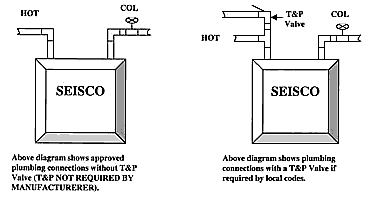Seisco Tankless Water Heaters
Plumbing Connections
Note: This heater must be installed to meet the current National Electric Code, and any applicable Local Plumbing, Electrical, Heating and Air Conditioning Codes.
Places to avoid installing the Seisco heater are in a crawl space under a house or building, in the garage (in regions prone to freezing or high humidity) and in the attic (unless the attic has been converted to living space). Like most appliances in the home, it is important to protect the Seisco heater from exposure to damp, humid and freezing conditions. In these environments, condensation from sweating pipes above and near the Seisco heater can drip down onto the plumbing connections and/or into the heater. This may cause corrosion at the plumbing connections or on components and electrical connections inside the heater. If it is necessary to install the Seisco heater on the second floor or in the attic, a drip pan with a drain should be installed below the heater to avoid damage to ceilings, walls and floors in the event of a leak. A drip pan is normally required for storage tank heaters located in the attic or on the second floor as well.
Unpack the heater from the shipping carton carefully. DO NOT CUT THE SHIPPING CARTON WITH A SHARP INSTRUMENT. Stand the unit upright and remove the plastic wrap. Remove the screws that hold the front cover. After removing the front cover, locate the four (4) mounting holes in the metal back plate. Position the unit against the wall with the two inlet and outlet fitting tubes pointed up toward the ceiling. Refer to Mounting Clearances in this section of the manual. Make sure the unit is level and attach to the wall with _ inch or larger lag bolts that are at least 1 _ inches long. If attaching to sheet-rock or paneling, anchors or molly bolts should be used to prevent the screws from pulling through the wall. If the heater is to be installed on a cinder block or concrete wall, attach a _ or _ inch section of plywood (20" x 20 " square) to the wall first. Then use wood screws to attach the heater to the plywood.
Attaching Water Supply
WARNING #1: Always use two wrenches when making any attachments of the water supply. Hold the heater’s inlet and outlet fittings secure while attaching the cold water and hot water lines. Never attempt to attach water lines to the heater’s fittings without using a second wrench to hold the fittings secure. The heater’s inlet and outlet fittings are designed to turn freely.
WARNING #2: Never solder water supply lines to the heater’s fittings. Heat from the soldering may damage the heat exchanger.
WARNING #3: Do not use Plumber’s Putty or PVC/CPVC primer and glue on the threads of the heater’s inlet and outlet fittings. Some of the putty compounds on the market are very aggressive and could potentially dissolve the threads on the heater’s fittings. PVC/CPVC primer and glue will also dissolve the threads on the heater’s fittings. Teflon Tape is the only sealer that should be used on the threads of the inlet and outlet fittings.

Temperature & Pressure Valve
A temperature and pressure relief valve (T&P Valve) may be required by local code. When a T&P valve is installed (which is not provided by the manufacturer), it should be checked after the water supply to the heater is turned on. With the water supply on, there should be no water flowing from the valve. Operate the valve manually two or three times to purge the trapped air from the top of the heater’s chamber. CLOSE VALVE. Water should stop flowing completely prior to connecting the drain piping to the valve.
SINCE THE SEISCO HEATER DOES NOT UTILIZE A STORAGE TANK, THE USE OF A T&P RELIEF VALVE IS NOT REQUIRED BY MANY NATIONAL STANDARDS, INCLUDING UL STANDARD 499. Seisco heaters are designed with control logic as well as elctro-mechanical high limit thermostat switches for over-temperature protection. With these built-in safety features, the use of a T&P Relief Valve is not required.
Drain Pan
If the Seisco heater is installed in an area where water damage can occur to the area adjacent to the heater, a drain pan must be installed. The pan must be at least 1 _ inches deep and large enough to protect the area below the heater (the pan should be at least 1 _ inches larger than the lower external dimensions of the heater) and must be piped by 1 inch pipe to a suitable drain. A splash cover must be included to protect the area of attachment to the wall.
NOTE: THIS HEATER MUST BE INSTALLED TO MEET THE CURRENT NATIONAL ELECTRICAL CODE, AND ANY APPLICABLE LOCAL PLUMBING, ELECTRICAL, OR HEATING AND AIR CONDITIONING CODES.
|